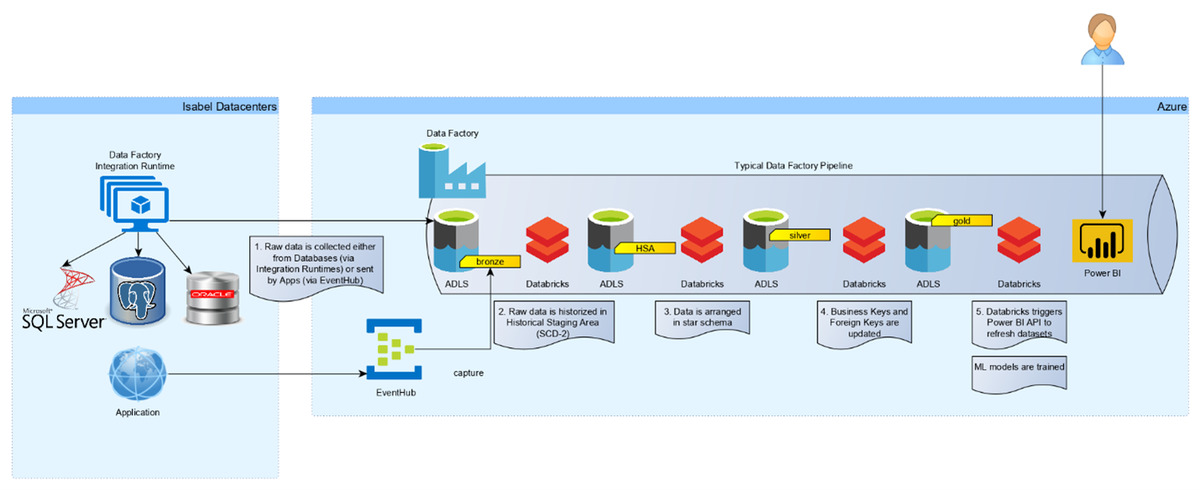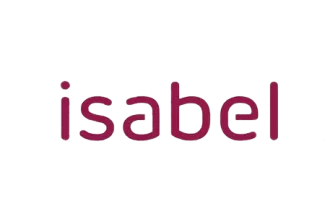This case study discusses the Cloud migration project at Isabel Group, setting up a Modern Data Platform in Azure.
Read here about the Analytics platform that Isabel initially has been setting up with element61 in 2012, and that was the subject of the migration.
The Customer
Through a variety of multi-banking services, Belgium-based Isabel Group has provided a reliable link between the business world, fiduciaries, banks, software providers, and consumers since 1995.
The Challenges
The organization’s original on-premises data platform lacked flexibility and was used only for BI purposes. Some tasks required manual operation and both employees and customers were limited in what they could accomplish. With a need to do more with its data, automate manual processes and add more complex ones, and also scale to accommodate growth and critical unstructured data, the company decided to reinvent its platform using Microsoft Azure Data Factory, Azure Data Lake Storage, Azure Databricks, and Power BI Premium. The expanded platform offers greater flexibility, supports unstructured data, and includes machine learning use cases, giving Isabel Group employees and customers the ability to do more with greater autonomy.
'Our analysis of the cloud computing market revealed Azure as a leader in data analytics.'
Michael Van de Borne: Data Analytics Manager - Isabel Group
The Solution
Part 1 - Removing business hassle with secure technology
For Isabel Group, simplification is a key to success. The Belgium-based fintech company’s core mission is removing hassle for customers through IT-based products that facilitate the exchange of documents, identities, and payments. In the complex world of financial administration, Isabel Group finds ways to streamline processes for its customers.
'It was a natural evolution to enter into the wider Microsoft ecosystem
both from a business continuity perspective and to ease the migration effort.'
Michael Van de Borne: Data Analytics Manager - Isabel Group
Part 2 - Technological limitations, manual operations, and employee frustrations
Isabel Group originally had an on-premises data platform that was used only for BI purposes. The BI platform was a traditional SQL server-based data warehouse with SQL Server Integration Services (SSIS), SQL Server Analysis Services, and SQL Server Reporting Services. Employees accessed data through multidimensional models and paginated reports. For reporting requests, business users were required to file a ticket and a BI developer would query the data warehouse.
The platform’s single-purpose construction meant that it couldn’t handle unstructured data or be utilized to support other critical business processes. Many operations did not use automation, resulting in repetitious, error-prone tasks that needed to be carried out manually. Because the solution used on-premises infrastructure, business users were forced to rely on database administrators and datacenter operators for managing physical upgrades, hindering their autonomy. The lack of flexibility prevented internal business users from improving processes like marketing campaigns and billing and forced business decision-makers to use inefficient tools to compensate for what the BI platform didn’t provide. “Or worse, they went without the proper data or no data at all,” says Van de Borne.
Isabel Group had an opportunity to simplify its own process—and unlock new business capabilities at the same time. The company needed a mature, scalable platform that could make use of machine learning and advanced analytics while offering seamless integration through every step of the data pipeline.
'Azure machine learning and data science can address all kinds of problems
that nobody believed we could solve previously.'
Michael Van de Borne: Data Analytics Manager - Isabel Group
Part 3 - A mature, scalable platform fit for machine learning
Going from an on-premises Microsoft SQL Server setup—where internal users worked on Windows laptops with Microsoft Office products—to an Azure ecosystem made sense. “It was a natural evolution to integrate into the wider Microsoft ecosystem both from a business continuity perspective and to ease the migration effort,” says Van de Borne. “Our analysis of the cloud computing market revealed Azure as a leader in data analytics.” Isabel Group also took advantage of Fast Track Support from Microsoft, which offered a series of workshops to evaluate how different Azure services could be used.
Part 4 - Technology used
Isabel Group built with element61 a solution using:
- Microsoft Azure Data Factory with self-hosted integration runtimes
- Azure Data Lake Storage for scaling and storage
- Azure Databricks for processing large datasets, and Microsoft Power BI Premium for insights and reporting
- Azure DevOps to build a custom toolchain, build and deploy models and reports to Power BI, and test and deploy data engineering code to Databricks
Part 5 - The Process
The process starts with raw data that is taken from databases via integration runtimes or sent by apps, then raw data is sent to the staging area in Azure Data Factory. Data is arranged in star schema and business keys and foreign keys are updated through Databricks, then Databricks triggers Power BI API to refresh datasets. With datasets refreshed, business insights are ready to be presented. The end-to-end process includes machine learning model training, a feature that Isabel Group wanted but was unable to fit into their old system.

Part 6 - More comprehensive data engineering and analysis
The process was a complete redevelopment of all the SSIS pipelines Isabel Group used—which number in the hundreds. After two and a half years of planning, problem-solving, and building custom tools and libraries, Isabel Group was able to fully decommission its on-premises BI platform and switch over to Azure.
With the move from traditional BI reporting to more comprehensive data engineering and analysis, Isabel Group gained the ability to process larger and unstructured datasets. Plus, the automation possibilities are a huge win for the team. Infrastructure and data pipelines are automated in the new solution—in fact, the team even automated the creation of new data pipelines, since so many needed to be migrated or remade. “This has unlocked a new range of possibilities,” says Van de Borne. “Alerts, in the case of a failure, and data quality tests are now automated.”
Conclusion
With the modern platform, the data team can provide new data initiatives more quickly and data engineers are more efficient. This means less time is needed to maintain pipelines and reports, and more time can be given to onboarding new use cases. For example, Van de Borne’s team has already begun work on new products used for validating the identity of payment beneficiaries in real time for help with fraud detection. As a result, employees have increased trust in the data team and platform, and Isabel Group can offer new services that continue to streamline and simplify business for its customers.
With the recently deployed platform, Isabel Group expects faster turnaround times for the creation of data products and machine learning-based solutions for both internal and external use. Employees are excited to explore advanced analytics and long-term, organization-wide data governance models. Insights into user usage patterns across product offerings will help steer future development of product features and identify cross-selling opportunities within its customer base. “Azure machine learning and data science can address all kinds of problems that nobody believed we could solve previously,” says Van de Borne.
